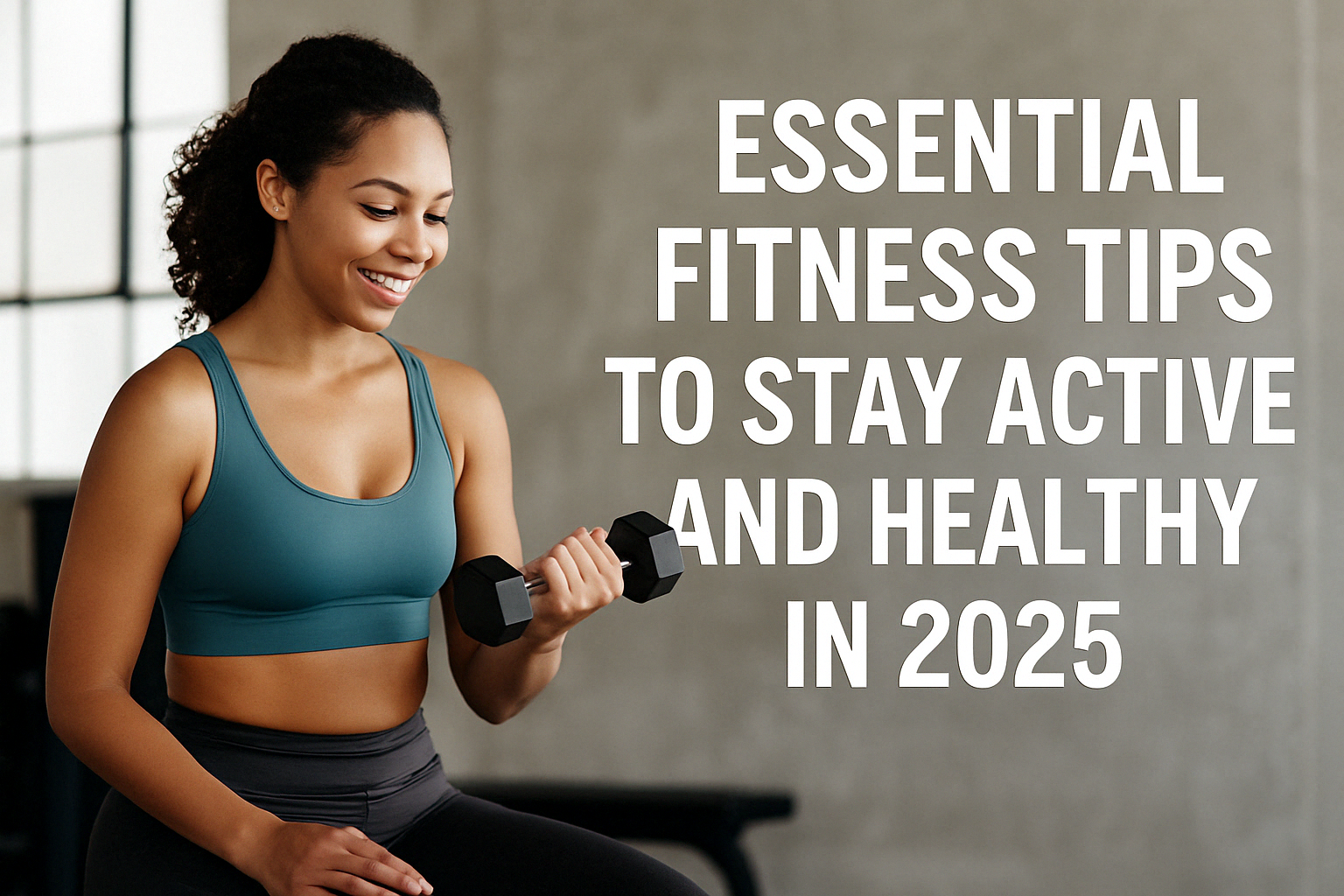Introduction
As we move into 2025, keeping our bodies strong and minds sharp matters more than ever. Busy schedules and digital lives can leave us sitting for hours. Yet small changes can make a big difference. In this article, we share essential fitness tips to help you stay active and feel healthy in 2025. You’ll learn how to weave short home workouts into your day, fuel your body with balanced nutrition, and build lasting fitness routines. We also cover smart recovery techniques and mindset training to keep you motivated. Let’s dive in and discover simple steps to boost your energy, strength, and well‑being all year long.
What Are Essential Fitness Tips?
Essential fitness tips are tried‑and‑true habits that support overall health. They include moving regularly, eating well, and resting enough. When combined, these steps help you avoid injury, prevent fatigue, and build strength over time. A good plan balances activity with recovery and focuses on long‑term consistency rather than quick fixes. By adopting these basic tips, you create a foundation for lasting wellness, even as life gets busy.
How to Stay Active Daily

Finding time to move can be hard. Yet regular activity is key to staying active and boosting mood. Here are simple ways to add motion to any schedule:
- Take short breaks every hour. Stand, stretch, or walk to the kitchen and back.
- Use the stairs instead of the elevator. Two flights once or twice a day builds leg strength.
- Park at the far end of the lot or get off the bus one stop early. A few extra steps add up.
- Do mini‑workouts at home: ten air squats, ten push‑ups, and a 30‑second plank. Repeat this circuit three times.
- Walk or cycle for errands when possible, rather than driving.
These micro‑habits make exercise feel natural, not forced. Over weeks, your daily movement adds up to hours of activity, helping you remain healthy in 2025.
Building an Effective Fitness Routine

A clear plan keeps you on track. To create a solid fitness routine, consider these steps:
- Set realistic goals.
Aim to exercise three to five times per week. Start with 20 minutes and build up gradually. - Mix workout types.
Combine cardio (walking, cycling), strength (bodyweight, light weights), and flexibility (yoga, stretching) for balanced results. - Schedule workouts.
Treat exercise like any other appointment. Block time in your calendar and stick to it. - Track progress.
Use a journal or app to note workouts, duration, and how you feel. Tracking boosts motivation and shows growth over time. - Adapt as needed.
If life gets busy, swap a long workout for two shorter sessions. Consistency matters more than length.
By following this framework, you build fitness routines that fit your life and evolve with your goals.
The Role of Balanced Nutrition

Fueling your workouts and recovery demands proper eating. Balanced nutrition means choosing a mix of protein, healthy fats, and complex carbs every day. Protein repairs muscles after a tough session. Fats support brain function and joint health. Carbs give steady energy for workouts and daily tasks.
To eat well:
- Fill half your plate with vegetables and fruits.
- Choose whole grains like brown rice, oats, and quinoa.
- Include lean proteins: eggs, beans, fish, or poultry.
- Add healthy fats from nuts, seeds, avocado, and olive oil.
- Limit processed snacks, sugary drinks, and excess salt.
Hydration is also critical. Drink water throughout the day, before and after exercise. Proper balanced nutrition and hydration help you power through workouts and recover faster.
How Nutrition Supports Your Physical Health

Exercise needs the right fuel. Healthy eating gives your body energy and helps muscles recover. In 2025, whole foods are key: fruits, vegetables, whole grains, beans, nuts, and seeds.
Aim for a plate that is half vegetables, a quarter lean protein (such as beans, tofu, or fish), and a quarter whole grains (like brown rice or quinoa). Add a small amount of healthy fat, such as olive oil or avocado.
Stay hydrated. Drinking water throughout the day helps muscles work and joints stay lubricated. Try to drink a glass of water before meals to aid digestion.
Limit sugary drinks, processed snacks, and too much salt. These can cause energy crashes and harm your heart. Swap soda for herbal tea or sparkling water with a slice of lemon.
Eating a small snack of protein and carbs after exercise helps your muscles recover. A banana with peanut butter or a yogurt with berries works well.
Smart Recovery Techniques
Rest is as vital as movement. Without proper rest, your body cannot repair and grow stronger. Incorporate these recovery techniques into your plan:
- Sleep: Aim for seven to nine hours per night. Quality sleep boosts muscle repair and mood.
- Active recovery: Light activities like walking or gentle yoga on rest days keep blood flowing and reduce soreness.
- Foam rolling: Roll out tight spots in your muscles for five to ten minutes. This eases tension and improves flexibility.
- Stretching: Hold major muscle stretches for 30 seconds each after workouts. This supports flexibility and range of motion.
- Mind‑body practices: Use deep breathing or guided relaxation to calm the nervous system and reduce stress.
By prioritizing rest, you ensure every workout counts and stay injury‑free on your path to being healthy in 2025.
Mindset Training for Long‑Term Success

Fitness is not just physical—your attitude matters too. Here’s how mindset training fuels success:
- Set process goals: Focus on consistency, such as “I will exercise three times this week,” rather than outcome goals like losing ten pounds.
- Use positive self‑talk: Replace “I can’t” with “I am getting stronger every day.”
- Visualize success: Spend a minute imagining finishing your workout with energy and pride.
- Celebrate small wins: Finished a tough circuit? Treat yourself to a healthy smoothie or ten‑minute relaxation.
- Find accountability: Partner with a friend or join a virtual group for shared motivation.
A strong mindset turns challenges into opportunities and keeps you committed when life gets hectic.
| Category | Tip Example | Benefit |
|---|---|---|
| Daily Activity | Stand and stretch every hour | Prevents stiffness, boosts energy |
| Routine Planning | Schedule three weekly workouts | Builds consistency |
| Balanced Nutrition | Half plate of vegetables, whole grains, lean protein | Fuels workouts, supports recovery |
| Recovery Techniques | Foam rolling and active recovery days | Reduces soreness, aids muscle repair |
| Mindset Training | Set process goals and use positive self‑talk | Increases motivation and resilience |
Conclusion
In 2025, staying active and feeling vibrant requires a blend of movement, proper eating, rest, and a strong mindset. By using simple essential fitness tips, you can weave home workouts, balanced nutrition, fitness routines, recovery techniques, and mindset training into your daily life. Short bursts of activity, a clear workout plan, and smart eating habits keep your energy high. Rest and positive thinking help you bounce back stronger. Start with one change today and build on it each week. These small steps lead to lasting health and vitality in 2025 and beyond.




